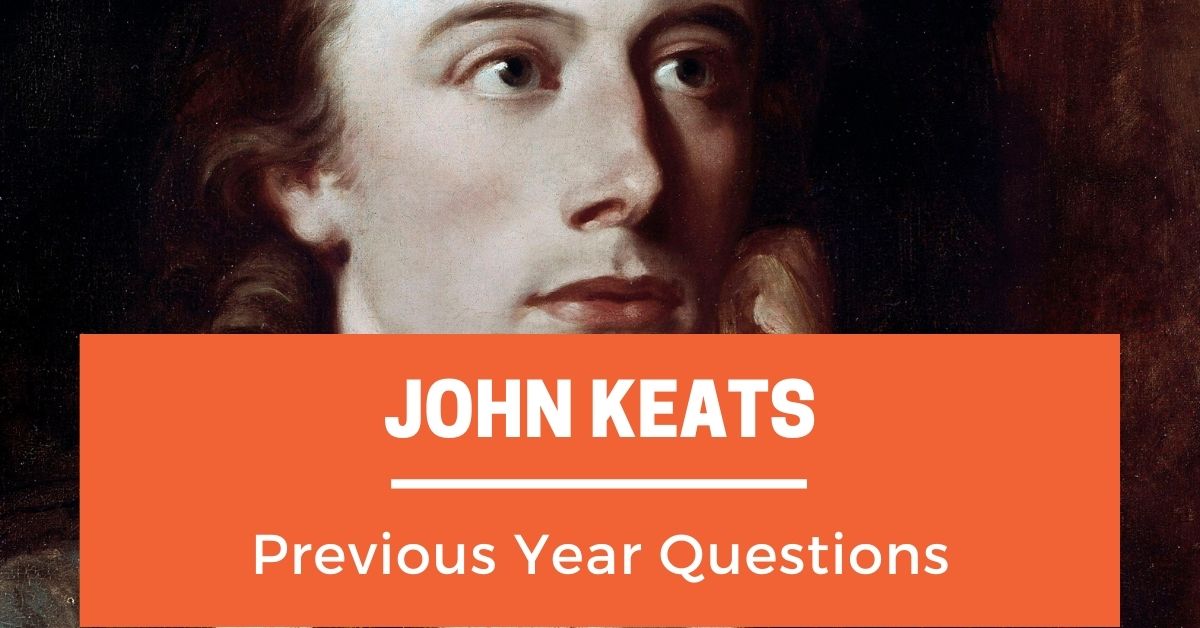UPDATE: Now, you can get these 3000+ questions in booklet/hardcopy format. Click here to know more.
John Keats Previous Year UGC-NET
1. “A thing of beauty is a joy for ever” occurs in:
2. What superstition around the Eve of St. Agnes is crucial to understanding John Keats’s famous poem?
3. “Thou wast no born for death immortal Bird.” In what sense is the Bird “immortal” as compared to mortal man?
Statements:
I. Here man as an individual is unfairly compared to a bird as a species.
II. The word “Bird” stands for the nightingale’s song.
III. When considered as a species man is equally “immortal” as the “Bird”.
IV. The “Bird” is “Immortal” because songs of birds have given pleasure to man through the ages.
Find the correct combination according to the code:
4. One of the most quoted statements on poetry by John Keats is reproduced with blanks below. Complete the statement with correct words.
“If Poetry __________ as naturally as the leaves to a tree, it __________ at all.”
5. Match the phrase to the ode:
Phrases:
(a) beechen green
(b) gathering swallows
(c) globed peonies
(d) green altar
Odes:
(i) “Ode on a Grecian Urn”
(ii) “Ode on Melancholy”
(iii) “Ode to a Nightingale”
(iv) “To Autumn”
Code: (a) (b) (c) (d)
6. What would help a reader recognize Keats’s “To Autumn” as a poem from the Romantic period?
7. Assertion (AST): Literary and historical periodization often has nothing to do with the lifetime of writers. Thus we see two writers born in the same year belonging to two separate periods. Reasoning/Example (R): Thomas Carlyle and John Keats were born in 1795. In standard literary histories, Keats is a Romantic and Carlyle, a Victorian.
8. In a letter to his brother George in September 1819, John Keats had this to say about a fellow romantic poet: “He describes what he sees – I describe what I imagine – Mine is the hardest task.” The poet under reference is
9. In Keats’ poetic career, the most productive year was
10. Which of the following poem by Keats uses the Spenserian stanza?
11. “___ the very word is like a bell To toll me back from thee to my sole self!” Which word?
12. The island setting of Latmos figures in Keats’s
13. Who defined poetry as ‘the best words in the best order’?
14. In the Fall of Hyperion Keats’s Muse figure is
15. “A rosy sanctuary will I dress With the wreathed trellis of a working brain.” The above lines are quoted from
16. With what does the speaker claim to be half in love in “Ode to a Nightingale”?
17. Which Keats’s poem was originally intended to be part of a collection of verse-tales based on stories by Boccaccio?
18. In The Fall of Hyperion: A Dream Keats sees a ladder leading upwards and is addressed by a prophetess in the following words: “None can usurp this height … / But those to whom the miseries of the world / Are misery, and will not let them rest.” Who is the prophetess?
19. Keats’s “La Belle Dame Sans Merci” combines two poetic forms
Poetic Forms:
I. Lyric
II. Dramatic Monologue
III. Ballad
IV. Sonnet
The right combination according to the code is:
20. Match the poem with the opening lines:
Poems:
(a) “Ode to Psyche”
(b) “Ode on a Grecian Urn”
(c) “Ode to a Nightingale”
(d) “Ode on Melancholy”
Opening Lines:
(1) “My heart aches, and a drowsy numbness pains my sense, as though of Hemlock I had drunk,”
(2) “No, no, go not to Lethe, neither twist Wolf’s-bane, tight-rooted, for its Poisonous wine,”
(3) “Thou still unravish’d bride of quietness, Thou foster-child of silence and Slow time,”
(4) “O Goddess ! hear these tuneless numbers, by sweet enforcement and Remembrance dear,”
21. Which interpretation of Keats’s “Beauty is truth, truth beauty” best represents the mimetic perspective?
22. Who among the following is celebrated in John Keats’s Lines on the Mermaid Tavern?
23. Which two of the following poems can be categorized as poems belonging to the neo-classical period of English literature?
Poems:
(a) “The Ring and the Book”
(b) “The Vanity of Human Wishes”
(c) “Cato”
(d) “Lamia”
Choose the correct option:

